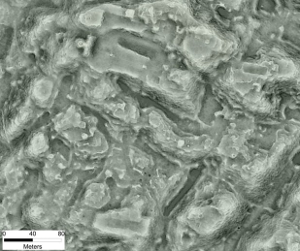|
LiDAR Reveals 'Medieval Manhattan' in Mexico
February 18, 2018
Hot on the heels of another success in Guatemala, researchers have used ground-breaking scanning technology to lift from obscurity a massive medieval settlement in what is now Mexico. Angamuco was built about A.D. 900 by the Purépecha, a civilization that rivaled the Aztecs. The Purépecha had a network of cities, including a capital at Tzintzúntzan, on the edge of Lake Pátzcuaro in today's western Mexico; descendants of those medieval people live in the area today. The technology was LiDAR, a scanning process that shoots super-quick lasers out of an airplane and measures how long it takes the light to bounce off what's on the ground and hit cutting-edge detectors onboard the plane. The process is similar to the ways that bats use sonar to hunt. LiDAR mapping speed can reach 150,000 pulses a second. What the archaeologists investigating Angamuco discovered was that city was twice as big as the capital and perhaps as big as today's Manhattan. The population of Angamuco would not have been as high, however; estimates are a high of about 100,000, between A.D. 1000 and A.D. 1350. The resarchers first found the remains of Angamuco in 2007 and have been employing traditional land-based methods of investigation. A few years later, they decided to embrace the relatively new technology of LiDAR, and the results have been surprising: more than 7,000 architectural features, including pyramids, temples, ball courts, roads, and large garden areas. The scans revealed remains of a city layout totalling more than 10 square miles that featured monuments and plazas dotted around the outskirts of the city, not in one central location, as was the traditional pattern of settlement in those days. Similar digital technology employed in 2015 revealed buried temples and other evidence of a much more complex settlement at Angkor Wat than had previously been thought and, more recently, to reveal a huge Maya settlement in what is now Guatemala. The Purépecha dominated what is now western Mexico, ruling an area of about 29,000 square miles, and were competitors to the Aztecs; the two civilizations clashed off and on but also traded extensively. The Purépecha were known for their skill and production in mining copper and obsidian and for their building of circular step pyramids known as yácata. The Purépecha fell victim to both smallpox and Spanish conquest in the 16th Century. The people survived, however, and their language is spoken today in Michoacán by nearly 200,000 people. |
Social Studies for Kids |
Social Studies for Kids
copyright 2002–2019
David White





